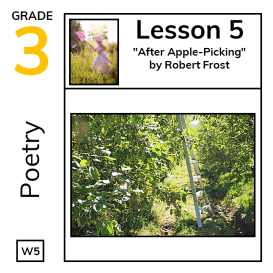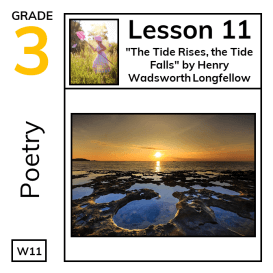By: Emily Dickinson
Week: 1
Emily Dickinson's 'I'm Nobody! Who are you?' presents a fun conundrum. How can 'Nobody' narrate a poem and ask the reader questions? 'Nobody' may refer to what others think of the narrator rather than a state of being. Perhaps a hidden word follows, such as 'Nobody Important' or 'Nobody Famous' or 'Nobody Notorious.' The narrator claims to favor their anonymity, comparing 'Somebodies' to a bunch of frogs ceaselessly croaking to their star-struck, marsh-inhabiting followers.
By: Emily Dickinson
Week: 2
Emily Dickinson's 'Hope is the Thing with Feathers' employs a feathered, soul-perching, singing, and ceaseless bird as a metaphor for hope. Imagine in your head, the inspiring sight of every person walking around with a little bird perched upon their soul, singing and inspiring us to keep trying in our darkest times.
By: Emily Dickinson
Week: 3
Emily Dickinson's 'Because I Could Not Stop for Death' ('The Chariot') depicts death as a dignified gentleman driving a carriage and kindly collecting the narrator before embarking on a leisurely drive toward eternity. On the way, they see children enjoying recess at school, fields of grain, the setting sun, and a strangely sunken house. Time flows differently during the carriage ride. A day in death's carriage lasts centuries in the human world.
By: Emily Dickinson
Week: 4
Emily Dickinson's 'By the Sea' describes a girl and her dog taking an early morning stroll along the sea. The tide eventually rises and drives her away. In stanzas one and two, the sea is a house with mermaids in the basement (under the water) and sailors upstairs (above the water). For the remaining stanzas, as the tide rises, the sea becomes a man who threatens to drown the narrator and chases her back to town.

By: Robert Frost
Week: 5
In Robert Frost's 'After Apple-Picking,' a laborer is exhausted after a long season of picking apples. There are still apples waiting to be picked off trees and an empty barrel, but the laborer is too tired to care. The image of apples, the feeling of standing on a swaying ladder, and the rumbling sound of tumbling apples haunts the laborer's mind while drifting off to sleep. The woodchuck has disappeared into its winter burrow, so the laborer cannot ask whether his sleep will be a groundhog-like hibernation or a regular human slumber.
By: Robert Frost
Week: 6
In Robert Frost's 'Ghost House,' a ghostly narrator describes his home, a cellar shell of a house long forgotten by living people. Nature is slowly reclaiming the abandoned property - the top of the house is gone and vegetation overgrows the fences, footpath, and road. The narrator's only companions are bats, birds, and the long ago buried folks whose tombstone-engraved names are obscured by moss.
By: Robert Frost
Week: 7
Robert Frost's 'October' describes the sights, sounds, and delights of the autumn month of October. The narrator asks October to beguile us and to move slowly to avoid spoiling the grapes before they can be harvested.
By: Robert Frost
Week: 8
In Robert Frost's 'The Lockless Door,' the narrator lives the life of a hermit, tucked away from the world within a refuge that has no visitors and needs no lock...until the day a knock sounds at the door. The narrator climbs out the window and stands outside before calling, 'Come in,' through the window. Just one knock changes the narrator's refuge into a hostile land and the outside hostile land into his refuge.
By: Henry Wadsworth Longfellow
Week: 9
Henry Wadsworth Longfellow's 'Haunted Houses,' describes the ethereal imprints of those who lived in our homes before us.
By: Henry Wadsworth Longfellow
Week: 10
Henry Wadsworth Longfellow's 'Paul Revere's Ride,' describes a real Revolutionary War event that Longfellow rearranged and dramatized to create a more compelling poem. In the poem, Paul Revere awaits a signal indicating the British are coming to Middlesex County, Massachusetts to fight the Americans. The famous line, 'One if by land, two if by sea;' means Revere's friend was to signal Revere by hanging one lantern from the church tower if the British were marching by land and two lanterns if the British were invading by sea. Two lanterns burn from the belfry, and through the night, Paul Revere rides to every Middlesex village and town to call the people to arms.

By: Henry Wadsworth Longfellow
Week: 11
Henry Wadsworth Longfellow's poem, 'The Tide Rises, the Tide Falls,' describes the never-ending rise and fall of the ocean as people go about their daily business. The business of people matters not to the sea. No matter what people do, the tide rises, the tide falls.
By: Henry Wadsworth Longfellow
Week: 12
The first stanza of Henry Wadsworth Longfellow's 'Snow-flakes,' describes the sky as a lady shaking snowflakes from the folds of her gown of clouds. The second and third stanzas describe how the snowflake sadness of the sky blankets the earth below.
By: Paul Laurence Dunbar
Week: 13
Paul Laurence Dunbar's 'We Wear the Mask,' describes how people wear the protective mask of a public persona to hide our vulnerable true selves and feelings. According to the book, 'Paul Laurence Dunbar,' by Peter Revell, Dunbar wrote specifically about how black Americans in the late nineteenth century felt pressured to pretend happiness in the face of racial discrimination and tensions.
By: Paul Laurence Dunbar
Week: 14
Paul Laurence Dunbar's 'The Seedling,' describes how a tiny, powerless seedling strives to become stronger (a plant) and more beautiful (a flower). Dunbar encourages every child to try their very best and conveys that persevering through both the good times and bad times will lead people to strength and beauty, just like the little seedling.
By: Paul Laurence Dunbar
Week: 15
Paul Laurence Dunbar's 'Sunset,' describes the sights, sounds, and activities surrounding the fall of day and the rise of night.
By: Paul Laurence Dunbar
Week: 16
Paul Laurence Dunbar's 'He Had His Dream,' describes someone who works his whole life toward a dream. He hasn't achieved his dream by the end of the poem, so he continues to toil and strive.
By: Christina Georgina Rossetti
Week: 17
Christina Georgina Rossetti's 'A Birthday,' uses several similes to describe the happiness of the narrator who is united with their true love. This poem doesn't celebrate a traditional birthday of a baby being born. Instead, the narrator celebrates the birthday of their new life, which has begun upon being reunited with their love.
By: Christina Georgina Rossetti
Week: 18
Christina Georgina Rossetti's 'Uphill,' employs a journey up a winding road as a metaphor for life. The poem features two people conversing, one asking questions and another answering the questions. The journey culminates at an inn, where there are beds for all who arrive.
By: Christina Georgina Rossetti
Week: 19
In Christina Georgina Rossetti's 'The Queen of Hearts,' the narrator describes that how no matter what she does, her competitor, Flora, always comes up with the Queen of Hearts. Even when the narrator cheats, Flora still wins the Queen of Hearts. Flora's constant victories continue to puzzle the narrator at the end of the poem.
By: Christina Georgina Rossetti
Week: 20
In Christina Georgina Rossetti's 'Summer,' the narrator discusses why they prefer summer over winter, spring, and autumn. The narrator also describes the plants and animals of summer and the superiority of the country over town.
By: Amy Lowell
Week: 21
In Amy Lowell's 'The Travelling Bear,' she invites the reader to empathize with a performing bear. To the poem spectators, the performance of the bear is delightful and fun. To the bear, his performance involves only fear and pain.
By: Amy Lowell
Week: 22
In Amy Lowell's 'To a Friend,' the narrator asks that a cherished friend remains upon their pedestal.
By: Amy Lowell
Week: 23
In Amy Lowell's 'Venus Transiens,' the narrator compares the beauty of someone she loves to the goddess Venus in Sandro Botticelli's painting, 'Birth of Venus,' and finds Venus lacking.
By: Amy Lowell
Week: 24
In Amy Lowell's 'Winter's Turning,' she describes the signs of the end of winter spotted in a panoramic view of a city.
By: John Keats
Week: 25
John Keats wrote 'Bright Star, would I were steadfast as thou art' for Fanny Brawne, his 'Bright Star,' to whom he formed a deep attachment. In the poem, Keats strives to remain as steady and eternal in his love as a bright star in the sky.
By: John Keats
Week: 26
John Keats' 'Ode to Autumn' personifies autumn and the sun as buddies working together to grow and ripen fruit and to bloom new fall flowers for the honey bees. Autumn can be found lurking everywhere, in stores of food, on granary floors, sleeping on a furrow in a field, and watching juice seep from apples in a cider press. The narrator encourages autumn to ignore the songs of spring and focus on its own special sounds, including the hum of gnats, the bleat of sheep, and the twitter of swallows gathering for their migration south.
By: John Keats
Week: 27
John Keats' 'On the Grasshopper and Cricket' describes how nature still hums along despite extremes in weather. In the hottest parts of summer, the grasshopper still sings. During the coldest snaps of winter, the cricket still chirps.
By: John Keats
Week: 28
John Keats' poem, 'To Sleep,' personifies sleep as being who uses its fingers to close our eyes and turn the key to lock our woes within our souls.
By: Walt Whitman
Week: 29
In the first stanza of Walt Whitman's 'A Noiseless Patient Spider,' a spider launches its thread to explore an ocean rock. In the second stanza, Whitman compares the spinning spider to his seeking and exploring soul.
By: Walt Whitman
Week: 30
Walt Whitman's 'Longings for Home,' describes the narrator's longing for his southern homeland.
By: Walt Whitman
Week: 31
Walt Whitman's 'Night on the Prairies,' is one of the poems found in his 'Leaves of Grass' collection. In the poem, the narrator leaves his travelling companions sleeping around the fire to take a walk under the star-filled night sky. There he ponders his day and contemplates life, death, existence, eternity, and the myriad of other worlds that surround him. The narrator realizes that just as the day cannot show all there is to see and know after nightfall, life cannot show all there is to see and know after death.
By: Walt Whitman
Week: 32
Walt Whitman's 'Pioneers! O Pioneers!' is one of the poems found in his "Leaves of Grass" collection. In the poem, the narrator calls on the brave, the strong, and the determined pioneers to make the journey to the American West to claim their destinies.
By: Elizabeth Barrett Browning
Week: 33
Elizabeth Barrett Browning's 'How Do I Love Thee?' attempts to quantify and express the depth of the narrator's love for another.
By: Elizabeth Barrett Browning
Week: 34
Elizabeth Barrett Browning's 'The Best Thing in the World' describes candidates for the best thing in the world and then concludes that perhaps the best thing is something not of this world.
By: Elizabeth Barrett Browning
Week: 35
Elizabeth Barrett Browning's 'The Musical Instrument' describes the mythological half-human and half-goat Pan making and playing a reed down by a river. Pan makes beautiful music, but it comes at the cost of the life of the reed, which grows no more.
By: Elizabeth Barrett Browning
Week: 36
Elizabeth Barrett Browning's 'Change Upon Change' compares the change from spring to winter with the cessation of love. For example, in the spring, rivers (love) rush(es) and in the winter they (love) still(s).
This mini dictionary includes definitions for the "Study Poem Vocabulary Words" activity.